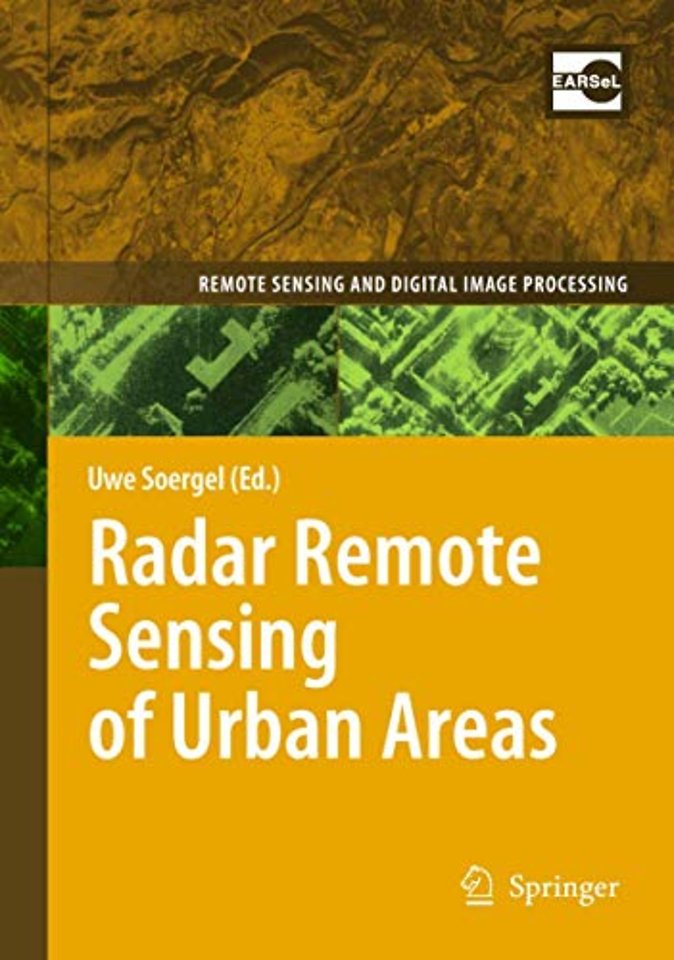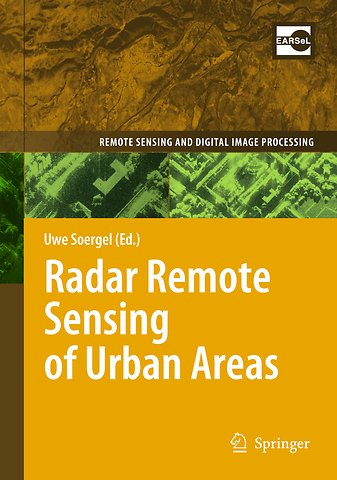Radar Remote Sensing of Urban Areas
Samenvatting
One of the key milestones of radar remote sensing for civil applications was the launch of the European Remote Sensing Satellite 1 (ERS 1) in 1991. The platform carried a variety of sensors; the Synthetic Aperture Radar (SAR) is widely cons- ered to be the most important. This active sensing technique provides all-day and all-weather mapping capability of considerably ?ne spatial resolution. ERS 1 and its sister system ERS 2 (launch 1995) were primarily designed for ocean app- cations, but soon the focus of attention turned to onshore mapping. Examples for typical applications are land cover classi?cation also in tropical zones and mo- toring of glaciers or urban growth. In parallel, international Space Shuttle Missions dedicated to radar remote sensing were conducted starting already in the 1980s. The most prominent were the SIR-C/X-SAR mission focussing on the investigation of multi-frequency and multi-polarization SAR data and the famous Shuttle Radar Topography Mission (SRTM). Data acquired during the latter enabled to derive a DEM of almost global coverage by means of SAR Interferometry. It is indispe- ableeventodayandformanyregionsthebestelevationmodelavailable. Differential SAR Interferometry based on time series of imagery of the ERS satellites and their successor Envisat became an important and unique technique for surface defor- tion monitoring. The spatial resolution of those devices is in the order of some tens of meters.
Specificaties
Inhoudsopgave
Uwe Soergel
1.1 Introduction
1.2 Basics
1.3 2d Approaches
1.4 3d Approaches
1.5 Surface Motion
1.6 Moving Object Detection
References
2 Rapid Mapping Using Airborne and Satellite SAR Images
Fabio Dell’Acqua and Paolo Gamba
2.1 Introduction
2.2 An Example Procedure
2.3 Examples on Real Data
2.4 Conclusions
References
3 Feature Fusion Based on Bayesian Network Theory for Automatic Road Extraction
Uwe Stilla and Karin Hedman
3.1 Introduction
3.2 Bayesian Network Theory
3.3 Structure of a Bayesian Network
3.4 Experiments
3.5 Discussion and Conclusion
References
4 Traffic Data Collection with TerraSAR-X and Performance Evaluation
Stefan Hinz, Steffen Suchandt, Diana Weihing, and Franz Kurz
4.1 Motivation
4.2 SAR Imaging of Stationary and Moving Objects
4.3 Detection of Moving Vehicles
4.4 Matching Moving Vehicles in SAR and Optical Data
4.5 Assessment
4.6 Summary and Conclusion
References
5 Object Recognition from Polarimetric SAR Images
Ronny H¨ansch and Olaf Hellwich
5.1 Introduction
5.2 SAR Polarimetry
5.3 Features and Operators
5.4 Object Recognition in PolSAR Data
5.5 Concluding Remarks
References
6 Fusion of Optical and SAR Images
Florence Tupin
6.1 Introduction
6.2 Comparison of Optical and SAR Sensors
6.3 SAR and Optical Data Registration
6.4 Fusion of SAR and Optical Data for Classification
6.5 Joint Use of SAR Interferometry and Optical Data for 3D Reconstruction
6.6 Conclusion
References
7 Estimation of Urban DSM from Mono-aspect InSAR Images
Celine Tison and Florence Tupin
7.1 Introduction
7.2 Review of Existing Methods for Urban DSM Estimation
7.3 Image Quality Requirements for Accurate DSM Estimation
7.4 DSM Estimation Based on a Markovian Framework
7.5 Conclusion
References
8 Building Reconstruction from Multi-aspect InSAR Data
Antje Thiele, Jan Dirk Wegner, and Uwe Soergel
8.1 Introduction
8.2 State-of-the-Art
8.3 Signature of Buildings in High-Resolution InSAR Data
8.4 Building ReconstructionApproach
8.5 Results
8.6 Conclusion
References
9 SAR Simulation of Urban Areas: Techniques and Applications
Timo Balz
9.1 Introduction
9.2 Synthetic Aperture Radar Simulation Development and Classification
9.3 Techniques of SAR Simulation
9.4 3D Models as Input Data for SAR Simulations
9.5 Applications of SAR Simulations in Urban Areas
9.6 Conclusions
References
10 Urban Applications of Persistent Scatterer Interferometry
Michele Crosetto, Oriol Monserrat, and Gerardo Herrera
10.1 Introduction
10.2 PSI Advantages and Open Technical Issues
10.3 Urban Application Review
10.4 PSI Urban Applications: Validation Review
10.5 Conclusions
References
11 Airborne Remote Sensing at MillimeterWave Frequencies
Helmut Essen
11.1 Introduction
11.2 Boundary Conditions for Millimeter Wave SAR
11.3 The MEMPHIS Radar
11.4 Millimeter Wave SAR Processing for MEMPHIS Data
References
Index

